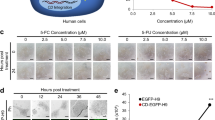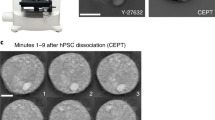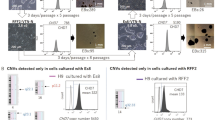Abstract
Generation of induced pluripotent stem (iPS) cells from patients has exciting applications for studying molecular mechanisms of diseases, screening drugs and ultimately for use in cell therapies. However, the low efficiency and heterogeneous nature of reprogramming is a major impediment to the generation of personalized iPS cell lines. We reported in Nature Methods (6, 370–376, 2009) the first selection system to enrich for reprogrammed human iPS cells. Using a lentiviral vector that specifically expresses the enhanced green fluorescence protein and puromycin resistance genes in pluripotent stem cells, it is now possible to mark and enrich for human iPS cell colonies expressing endogenous pluripotency markers. In this study, we describe a detailed protocol for the production of the pluripotent state-specific lentiviral vector and the selection system for the induction of healthy and disease-specific human iPS cells. Overall, preparation of the selection system takes 2 weeks, and the generation of human iPS cells takes ∼2 months.
This is a preview of subscription content, access via your institution
Access options
Subscribe to this journal
Receive 12 print issues and online access
$259.00 per year
only $21.58 per issue
Buy this article
- Purchase on Springer Link
- Instant access to full article PDF
Prices may be subject to local taxes which are calculated during checkout






Similar content being viewed by others
References
Takahashi, K. et al. Induction of pluripotent stem cells from adult human fibroblasts by defined factors. Cell 131, 861–872 (2007).
Yu, J. et al. Induced pluripotent stem cell lines derived from human somatic cells. Science 318, 1917–1920 (2007).
Park, I.H. et al. Reprogramming of human somatic cells to pluripotency with defined factors. Nature 451, 141–146 (2008).
Takahashi, K., Okita, K., Nakagawa, M. & Yamanaka, S. Induction of pluripotent stem cells from fibroblast cultures. Nat. Protoc. 2, 3081–3089 (2007).
Maherali, N. & Hochedlinger, K. Guidelines and techniques for the generation of induced pluripotent stem cells. Cell Stem Cell 3, 595–605 (2008).
Ellis, J. et al. Alternative induced pluripotent stem cell characterization criteria for in vitro applications. Cell Stem Cell 4, 198–199 (2009).
Daley, G.Q. et al. Broader implications of defining standards for the pluripotency of iPSCs. Cell Stem Cell 4, 200–201 (2009).
Yamanaka, S. A fresh look at iPS cells. Cell 137, 13–17 (2009).
Lowry, W.E. et al. Generation of human induced pluripotent stem cells from dermal fibroblasts. Proc. Natl. Acad. Sci. USA 105, 2883–2888 (2008).
Huangfu, D. et al. Induction of pluripotent stem cells from primary human fibroblasts with only Oct4 and Sox2. Nat. Biotechnol. 26, 1269–1275 (2008).
Tiscornia, G., Singer, O. & Verma, I.M. Production and purification of lentiviral vectors. Nat. Protoc. 1, 241–245 (2006).
Hotta, A. et al. Isolation of human iPS cells using EOS lentiviral vectors to select for pluripotency. Nat. Methods 6, 370–376 (2009).
Maksakova, I.A. & Mager, D.L. Transcriptional regulation of early transposon elements, an active family of mouse long terminal repeat retrotransposons. J. Virol. 79, 13865–13874 (2005).
Okumura-Nakanishi, S., Saito, M., Niwa, H. & Ishikawa, F. Oct-3/4 and Sox2 regulate Oct-3/4 gene in embryonic stem cells. J. Biol. Chem. 280, 5307–5317 (2005).
Tomioka, M. et al. Identification of Sox-2 regulatory region which is under the control of Oct-3/4-Sox-2 complex. Nucleic Acids Res. 30, 3202–3213 (2002).
Buzina, A. et al. Beta-globin LCR and intron elements cooperate and direct spatial reorganization for gene therapy. PLoS Genet. 4, e1000051 (2008).
Zufferey, R. et al. Self-inactivating lentivirus vector for safe and efficient in vivo gene delivery. J. Virol. 72, 9873–9880 (1998).
Osborne, C.S. et al. Amelioration of retroviral vector silencing in locus control region beta-globin-transgenic mice and transduced F9 embryonic cells. J. Virol. 73, 5490–5496 (1999).
Nakagawa, M. et al. Generation of induced pluripotent stem cells without Myc from mouse and human fibroblasts. Nat. Biotechnol. 26, 101–106 (2008).
Hotta, A. & Ellis, J. Retroviral vector silencing during iPS cell induction: an epigenetic beacon that signals distinct pluripotent states. J. Cell. Biochem. 105, 940–948 (2008).
Park, I.H., Lerou, P.H., Zhao, R., Huo, H. & Daley, G.Q. Generation of human-induced pluripotent stem cells. Nat. Protoc. 3, 1180–1186 (2008).
Ohnuki, M., Takahashi, K. & Yamanaka, S. Generation and characterization of human induced pluripotent stem cells. Curr. Protoc. Stem. Cell Biol. Chapter 4, Unit 4A.2 (2009).
Soldner, F. et al. Parkinson's disease patient-derived induced pluripotent stem cells free of viral reprogramming factors. Cell 136, 964–977 (2009).
Woltjen, K. et al. piggyBac transposition reprograms fibroblasts to induced pluripotent stem cells. Nature 458, 766–770 (2009).
Kaji, K. et al. Virus-free induction of pluripotency and subsequent excision of reprogramming factors. Nature 458, 771–775 (2009).
Yu, J. et al. Human induced pluripotent stem cells free of vector and transgene sequences. Science 324, 797–801 (2009).
Kim, D. et al. Generation of human induced pluripotent stem cells by direct delivery of reprogramming proteins. Cell Stem Cell 4, 472–476 (2009).
Ding, S. et al. Efficient transposition of the piggyBac (PB) transposon in mammalian cells and mice. Cell 122, 473–483 (2005).
Hotta, A. et al. Characterization of transient expression system for retroviral vector production. J. Biosci. Bioeng. 101, 361–368 (2006).
Burns, J.C., Friedmann, T., Driever, W., Burrascano, M. & Yee, J.K. Vesicular stomatitis virus G glycoprotein pseudotyped retroviral vectors: concentration to very high titer and efficient gene transfer into mammalian and nonmammalian cells. Proc. Natl. Acad. Sci. USA 90, 8033–8037 (1993).
Sastry, L., Johnson, T., Hobson, M.J., Smucker, B. & Cornetta, K. Titering lentiviral vectors: comparison of DNA, RNA and marker expression methods. Gene Ther. 9, 1155–1162 (2002).
Villegas, J. & McPhaul, M. Establishment and culture of human skin fibroblasts. Curr. Protoc. Mol. Biol. Chapter 28, Unit 28.23 (2005).
Morita, S., Kojima, T. & Kitamura, T. Plat-E: an efficient and stable system for transient packaging of retroviruses. Gene Ther. 7, 1063–1066 (2000).
Campbell, R.E. et al. A monomeric red fluorescent protein. Proc. Natl. Acad. Sci. USA 99, 7877–7882 (2002).
Bryja, V., Bonilla, S. & Arenas, E. Derivation of mouse embryonic stem cells. Nat. Protoc. 1, 2082–2087 (2006).
Michalska, A. Isolation and propagation of mouse embryonic fibroblasts and preparation of mouse embryonic feeder layer cells. Curr. Protoc. Stem. Cell. Biol. Chapter 1, Unit 1C 3 (2007).
Lifson, J.D., Sasaki, D.T. & Engleman, E.G. Utility of formaldehyde fixation for flow cytometry and inactivation of the AIDS associated retrovirus. J. Immunol. Methods 86, 143–149 (1986).
Acknowledgements
We thank P. Leboulch (Genetics Division, Department of Medicine, Brigham & Women's Hospital and Harvard Medical School) for PL lentiviral vector and packaging plasmids, T. Kitamura (Institute of Medical Science, University of Tokyo) for Plat-E cells and B. Alman for provision of human fibroblasts. We thank T. Thompson, C.A. Séguin and K. Woltjen at the Ontario Human iPS Cell Facility for infrastructure and reagents and J. Garner at the SickKids ES Facility for feeder preparation. This study was supported by grants from the Canadian Institutes of Health Research (MOP-81129, RMF-92090, and IG1-94505 to J.E. and MOP-186015 to W.L.S.), the Ontario Ministry of Research and Innovation (to J.E. and W.L.S. for the Ontario Human iPS Cell Facility), the Stem Cell Network (to J.E. and W.L.S.) and the International Rett Syndrome Foundation (to J.E.). A.H. is supported by a Restracomp Award from SickKids Hospital, A.Y.L.C. by a Graduate Scholarship from the Natural Sciences and Engineering Research Council of Canada, N.F. by an Ontario Council of Graduate Studies Master's Autism Scholars Award and the Ontario Student Opportunity Trust Funds Hayden Hantho Award and W.Y.C. by an Ontario Ministry of Research and Innovation Postdoctoral Fellowship.
Author information
Authors and Affiliations
Contributions
A.H. developed the selection protocol; A.Y.L.C., N.F., K.G. and W.Y.C. derived iPS cell lines, P.P. performed teratoma experiments; W.L.S. and J.E. conceived the study; A.H. and J.E. wrote the paper; and all authors contributed to optimize the protocol and edit the paper.
Corresponding author
Rights and permissions
About this article
Cite this article
Hotta, A., Cheung, A., Farra, N. et al. EOS lentiviral vector selection system for human induced pluripotent stem cells. Nat Protoc 4, 1828–1844 (2009). https://doi.org/10.1038/nprot.2009.201
Published:
Issue Date:
DOI: https://doi.org/10.1038/nprot.2009.201
This article is cited by
-
Wide spectrum of neuronal and network phenotypes in human stem cell-derived excitatory neurons with Rett syndrome-associated MECP2 mutations
Translational Psychiatry (2022)
-
JNK signaling provides a novel therapeutic target for Rett syndrome
BMC Biology (2021)
-
Conversion of human and mouse fibroblasts into lung-like epithelial cells
Scientific Reports (2019)
-
Putative cancer stem cells may be the key target to inhibit cancer cell repopulation between the intervals of chemoradiation in murine mesothelioma
BMC Cancer (2018)
-
Fyn Kinase regulates GluN2B subunit-dominant NMDA receptors in human induced pluripotent stem cell-derived neurons
Scientific Reports (2016)
Comments
By submitting a comment you agree to abide by our Terms and Community Guidelines. If you find something abusive or that does not comply with our terms or guidelines please flag it as inappropriate.



